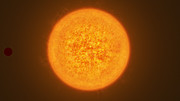Exomoon orbiting its planet (artist’s impression)
Videos
Neptune-sized moon orbits Jupiter-sized planet
Using the NASA/ESA Hubble Space Telescope
and older data from the Kepler Space Telescope two astronomers have
found the first compelling evidence for a moon outside our own Solar
System. The data indicate an exomoon the size of Neptune, in a stellar
system 8000 light-years from Earth. The new results are presented in the
journal Science Advances.
The hunt for exoplanets
— planets outside our own Solar System — provided its first results
only 30 years ago. While astronomers now find these planets on a regular
basis, the search for moons orbiting exoplanets wasn’t successful —
until today.
In 2017 NASA’s Kepler Space Telescope detected hints of an exomoon orbiting the planet Kepler-1625b. Now, two scientists from Columbia University in New York (USA) have used the incomparable capabilities of the NASA/ESA Hubble Space Telescope to study the star Kepler-1625,
8000 light-years away, and its planet in more detail. The new
observations made with Hubble show compelling evidence for a large
exomoon orbiting the only known planet of Kepler-1625. If confirmed,
this would be the first discovery of a moon outside our Solar System.
The candidate moon, with the designation Kepler-1625b-i, is unusual
because of its large size; it is comparable in diameter to the planet Neptune. Such gargantuan moons are unknown in our own Solar System.
“This may yield new insights into the development of planetary systems
and may cause astronomers to revisit theories of how moons form,” Alex Teachey, a graduate student who led the study, explained excitedly [1].
Like its moon, Kepler-1625b is also bigger than its counterparts in
the Solar System. The exoplanet is a gas giant, several times more
massive than Jupiter [2].
It orbits its parent star at a distance similar to the distance between
the Sun and Earth, which puts it — and its candidate moon — at the
inner edge of the habitable zone of the star system [3].
To find evidence for the existence of the exomoon, the team observed the planet while it was in transit in front of its parent star, causing a dimming of the starlight. “We saw little deviations and wobbles in the light curve that caught our attention,” David Kipping, second author of the study, said.
The planet was observed by Hubble before and during its 19-hour-long
transit. After the transit ended, Hubble detected a second and much
smaller decrease in the star’s brightness approximately 3.5 hours later,
consistent with the effect of a moon trailing the planet. “It was
definitely a shocking moment to see that light curve — my heart started
beating a little faster and I just kept looking at that signature,”
David Kipping described his feelings. Unfortunately, the scheduled
Hubble observations ended before the complete transit of the moon could
be captured.
In addition to this second dip in the light curve, Hubble provided
compelling supporting evidence for the moon hypothesis by detecting the
planet’s transit more than an hour earlier than predicted. This is
consistent with a model of the system in which the planet and its moon
orbit a common centre of gravity, causing the planet to wobble away from
its predicted location [4].
In principle this anomaly could also be caused by the gravitational
pull of a hypothetical second planet in the system, but the Kepler Space
Telescope found no evidence for additional planets around the star
during its four year mission. Still, further observations by Hubble are
needed to fully confirm the existence of Kepler-1625b-i.
“If confirmed, Kepler-1625b-i will certainly provide an interesting puzzle for theorists to solve,” said Kipping. Teachey concluded: “It
is an exciting reminder of how little we really know about distant
planetary systems and the great spirit of discovery exoplanetary science
embodies.”
Notes
[1] The moons of Jupiter and Saturn likely formed through the
agglomeration into a disc of material orbiting the planets, so it is
possible that this exomoon also formed in a circumplanetary disc.
Another possibility is that a passing object was captured by the
planet’s gravity. Tidal forces between the two objects would rob
momentum from the less massive companion and eventually pull it into a
permanent orbit. There are no indications of tidal capture among our
Solar System’s moons. In the case of the Earth–Moon system, an early
collision with a larger body is hypothesised to have blasted off
material that later coalesced into a moon. However, Kepler-1625b and its
candidate moon are gaseous, not rocky, so such a collision would not
have led to the condensation of a satellite.
[2] Despite its size, the mass of the
candidate moon is estimated to be only 1.5 percent of the mass of its
companion planet. This value is close to the mass ratio between Earth
and the Moon.
[3] While both the planet and its
candidate moon are within the habitable zone, where moderate
temperatures allow for the existence of liquid water, both bodies are
considered to be gaseous and therefore unsuitable for life as we know
it.
[4] A distant observer watching the
Earth and Moon transit the Sun would note similar anomalies in the
timing of Earth’s transit.
More Information
The Hubble Space Telescope is a project of international cooperation between ESA and NASA.
The results were presented in the paper Evidence for a large exomoon orbiting Kepler-1625b in the journal Science Advances.
The team of astronomers in this study consists of Alex Teachey and David M. Kipping (Columbia University, New York, USA).
Image credit: NASA, ESA
Links
Contacts
Alex Teachey
Columbia University
New York, USA
Email: ateachey@astro.columbia.edu
David M. Kipping
Columbia University
New York, USA
Email: dkipping@astro.columbia.edu
Mathias Jäger
ESA/Hubble, Public Information Officer
Garching, Germany
Cell: +49 176 62397500
Email: mjaeger@partner.eso.org
Source: ESA/Hubble/News

